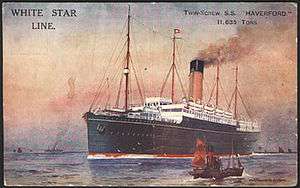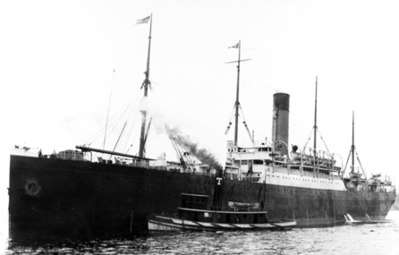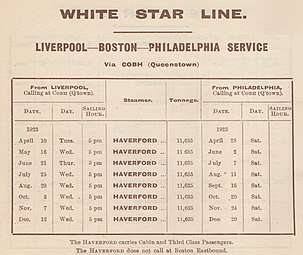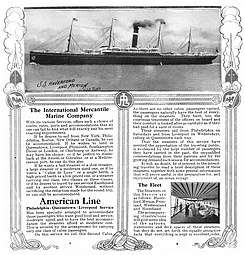SS Haverford
SS Haverford was an American transatlantic liner commissioned in 1901 for the American Line. During World War One, Haverford was utilized as a troop transport vessel in the North Atlantic Ocean. Following the war, the White Star Line purchased and recommissioned the ship. She was decommissioned in 1924 and scrapped in 1925.
 1920 postcard of SS Haverford | |
| History | |
|---|---|
| Name: | SS Haverford |
| Owner: |
|
| Operator: |
|
| Port of registry: |
|
| Route: |
|
| Builder: | John Brown & Company, Clydebank |
| Yard number: | 345[1] |
| Launched: | 4 May 1901[1] |
| Completed: | 1901[1] |
| Maiden voyage: | Southampton-New York, 4 May 1901 |
| Fate: | scrapped 1925 |
| Notes: |
one of the largest ships hit by U-boats in World War I Sister ship: SS Merion |
| General characteristics | |
| Type: | ocean liner |
| Tonnage: | 11,621 GRT[1] |
| Length: | 161.7 m (530 ft 6 in)[1] |
| Beam: | 18.0 m (59 ft 1 in)[1] |
| Propulsion: |
|
| Speed: | 14 knots (26 km/h; 16 mph)[1] |
| Passengers: |
|
| Armament: | 4 x 6 inches (15 cm) guns (as merchant ship, 1914)[2] |
| Notes: |
One funnel; Four masts; Twin screws Identical design to her sister ship: SS Merion |
Transatlantic Liner (1901–1915)
.jpg)
SS Haverford was constructed by John Brown & Company of Clydebank, Scotland and funded by Clement Griscom Director of the International Navigation Company.
The Haverford and her sister ship, SS Merion are identical in design and named after two suburbs on the Philadelphia Main Line just west of Pennsylvania's largest city. The ships were designed for a single passenger classification with accommodations called "Second Cabin" considered equal to first class on other ships. SS Haverford was launched on 4 May 1901, six months prior to SS Merion.[3]
After briefly serving the Southampton to New York route, Haverford was transferred to the Liverpool – Philadelphia route by 1903. The ship also occasionally was used by other lines in the International Mercantile Marine Company serving for the Red Star Line ( Antwerp-New York route) and Dominion Line (Liverpool-Halifax-Portland).[4]
On 14 June 1906 an explosion occurred aboard Haverford, killing 13 people at Liverpool docks. The explosion was attributed to explosive fumes produced by a load of 45 tons of Fels-Naptha soap in its cargo. The ship's owners attempted to sue the manufacturers of the soap, but the case was rejected by the United States District Court as adequate ventilation was not provided aboard the ship to deal with the known hazards of Naptha fumes.[5][6][7]
World War One (1915–1920)
During World War I, Haverford was used as a transport ship for British troops, beginning in 1915. In 1917, the ship suffered heavy damage in a torpedo attack off the west coast of Ireland by the German U-boat, U-94. In 1918, after a six-month hiatus for repairs, the ship was again attacked by a German submarine in the North Atlantic Ocean, surviving with far less damage.[8]
Post World War One (1920–1925)

Haverford returned to passenger service on the Philadelphia-Liverpool route for the American Line, making its first voyage in June,1920. In Philadelphia, the ships docked at Pier 53, the site of the former Washington Avenue Immigration Station (1873–1915). After 1915, immigrants were processed onboard arriving ships.[9] The Haverford was purchased by White Star Line in 1921 and retained the original ship name. This was unusual for White Star, as most purchased vessels' names were changed to a more typical White Star name, usually ending in "-ic". The ship was assigned to the Liverpool-Philadelphia route as well as the Hamburg-New York route. She experienced compound structural and electrical problems in 1924, relegating it to dry dock. After making her final voyage from Liverpool to Philadelphia, the Haverford was decommissioned in 1924 and moved to Italy, where she was scrapped in 1925.
Gallery
 SS Haverford
SS Haverford_(14782772552).jpg) The port of Philadelphia (1914)
The port of Philadelphia (1914) Sailings of the "Haverford", April–December 1923
Sailings of the "Haverford", April–December 1923 American Line 1907 brochure SS Haverford/SS Merion Philadelphia-Queenstown-Liverpool service
American Line 1907 brochure SS Haverford/SS Merion Philadelphia-Queenstown-Liverpool service
References
- "Merion (1115257)". Miramar Ship Index. Retrieved 3 March 2009.
- "Sails with guns in hold". The New York Times. 6 September 1914. p. 4.
- Kinghorn, Jonathan (2014). "S.S. Merion". www.atlantictransportline.us. Retrieved 6 February 2017.
- Kinghorn, Jonathan (2005–2014). "S.S. Haverford". www.atlantictransportline.us. Retrieved 30 October 2016.
- "Explosion on the steamship HAVERFORD, 1906". Old Mersey Times. 2013. Retrieved 12 March 2017.
- "Haverford Explosion". Evening Express and Evening Mail. Cardiff. 14 July 1906. p. 2. Retrieved 12 March 2017 – via Welsh Newspapers Online.
- "The Fleets of the Mail Lines: The "Haverford"". The Marine Engineer and Naval Architect. Vol. 31. 1 August 1908. p. 10.
- "S/S Haverford, American Line". Norway Heritage. Retrieved 30 December 2018.
- UJIFUSA, STEVEN (21 March 2013). "A Philadelphia Quaker and Fabric Row". www.phillyhistory.org. Retrieved 6 February 2017.